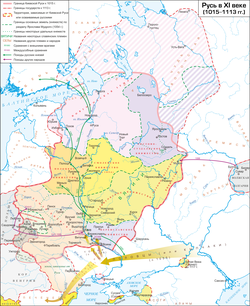Principality of Turov
Principality of Turov and Pinsk | |||||||||
|---|---|---|---|---|---|---|---|---|---|
| 10th century–14th century | |||||||||
 | |||||||||
| Status | Principality | ||||||||
| Capital | Turov Pinsk | ||||||||
| Common languages | Old East Slavic | ||||||||
| Religion | Eastern Orthodoxy | ||||||||
| Government | Monarchy | ||||||||
| Prince | |||||||||
• 950–980 | Tur | ||||||||
| Legislature | Veche | ||||||||
| History | |||||||||
• Established | 10th century | ||||||||
• Incorporation into the Grand Duchy of Lithuania | 14th century | ||||||||
| |||||||||
The Principality of Turov, later called the Principality of Turov and Pinsk (
Until the 12th century, the principality was very closely associated with the principalities of Kiev and Volhynia. Later for a short period time until the Mongol invasion it enjoyed a wide degree of autonomy when it was annexed to the Kingdom of Galicia–Volhynia. In the 14th century, it became part of the Grand Duchy of Lithuania
History
The Principality of Turov originated mainly from the
Kiev Principality
During the times of
Izyaslavichi
In a series of three battles during 1016-1018,
In 1078 after Izyaslav's death, Isyaslav's brother and new Grand Prince,
Opposition to Vladimir Monomakh
The Turov principality was passed to his younger brother
The 1097 Council of Liubech modified the rota system such that the Principality became patrimonial land.
Reinstatement
After the death of Bryachislav Vladimir, Monomakh gave the Turov principality to his Vyacheslav who kept it until the middle of the 12th century. Around the 1150s Turov belonged to the descendants of
Decline
In the early 13th century the Principality of Turov became dependent of the
Regions of the Principality
- Principality of Turov (10th century - 14th century)
- Principality of Pinsk (12th century - 16th century)
- Principality of Kletsk (12th century - 15th century)
- Principality of Slutsk-Kopyl (12th century - 16th century)
- Principality of Dubrovytsia (12th century - 13th century)
Leaders
| History of Belarus |
|---|
| Prehistory |
| Middle ages |
|
Early Modern |
|
| Modern |
|
|
|
| History of Ukraine |
|---|
 |
|
|
Prince of Turov
- Sviatopolk IAccursed (980-1019)
- Izyalavichi
- Izyaslav I Yaroslavich(about 1045-1078)
- Yaropolk Petr Izyaslavich(1078–1087)
- Sviatopolk II Mikhail Izyaslavich(1087–1094)
- Vyacheslav Yaropolkovich (1094-1104/1105|5)
- Monomakh (of Smolensk)
- Vyacheslav Monomakhovich (1125–1132)
- Izyaslav II Monomakhovich (1133–1134)
- Vyacheslav Monomakhovich (1134–1141)
- Vyacheslav Monomakhovich (1142–1146)
- ?
- Dolgoruky
- Andrei I Yuryevich (1150–1151)
- ?
- Borys I(1155–1157)
- Yuryevichi (Izyaslavichi's branch)
- Yuri Yaroslavovich (1157–1167)
- Ivan Yuryevich (1167–1190)
- Gleb (1190–1195)
- Ivan Yuryevich (1195–1207)
- Rostislav Glebovich (1207–1228)
- ?
- Yuri Volodymyrovich (?-1292)
- Dmitry Yuryevich (1292-)
- Danila Dmitrovich (?-before 1366)
Prince of Pinsk
- Yuryevichi (Izyaslavichi's branch)
- Yaroslav Yurievich (-1184-)
- Volodimir Glebovich (-1228-)
- Rostislav Volodimirovich (-1242-)
- Fiodor Volodimirovich (-1262-)
- Yuri Volodimirovich (-1292)
- Demid Volodimirovich (1292-to 1292)
- Yaroslav Yurievich (to 1292-)
- Yuri Dimitrovich
- Gediminas (1320- ?)
- Narymunt Gleb (1340–1348)
- Mikhail Glebovich Narymuntovich (1348-?)
- Vasili Mikhailovich Narymuntovich (14th century)
- Yuri Nos Vasilievich Narymuntovich (before 1398- after 1410)
- Yuri Semenovich (before 1440-after 1471)
- Maria Olelkovich (1471–1501)
- Vasili Olelkovich (1480–1495)
- Fiodor Ivanovich Yaroslavich (1501–1521)
Prince of Kletsk
- Yuryevichi (Izyaslavichi's branch)
- Wiaczesław Jarosławicz (1127- ?)
- ?
- Michał Zygmuntowicz (1442–1452)
Prince of Slutsk-Kopyl
- Yaroslav Iziaslavovich ? (1148)
- Sviatoslav Olegovich (1148–1162
- Volodimir Mstislavovich (1162–1164) ?
- ?
- Volodimir Olgierdovich (1395–1398)
- Aleksandr Olelko (1398–1454)
- Michail Olelkovich (1454-1470/1481)
- Simeon I Olelkovich (1481–1505)
- Yuri I Olelkovich (1505–1542)
- Simeon II Olelkovich (1542–1560)
- Yuri II Olelkovich (1560–1572)
- Yuri III Olelkovich (1572–1586)
Prince of Dubrovytsia
- Ivan Yurievich (1166–1182) ?
- Gleb Yurievich (1182–1190)
- Aleksandr Glebovich (1190–1223)
References
- ^ Jan Tyszkiewicz (2015): The stronghold in Sypniewo from the 10th–11th century (p. 295)
- ISBN 9781317872245.
There arrived 'from overseas' a certain Rogvolod (Ragnvaldr in Old Norse). He installed himself on the Western Dvina at Polotsk, reportedly enjoying princely status. Likewise, Tur or Tury set himself up in a promontory fort by the Pripet, staying there long enough to leave his name on the place, Turov. It seems to have been a recent foundation, if not his own.
Bibliography and external links
- Primary Chronicle
- Ermolovich M.I., Ancient Belarus - Polotsk and Novogrudskii period, 1990 (Ермаловіч М. І. Старажытная Беларусь. Полацкі і Навагародскі перыяд. Мн., 1990.) (in Belarusian)
- Saganovich G., Outline of the History of Belarus from antiquity to the end of 18th century (Сагановіч Г. Нарыс гісторыі Беларусі ад старажытнасці да канца XVIII ст. Мн., 2001.) (in Belarusian)
- Hrushevsky, M. "History of Ukraine-Rus". Vol.2 Ch.4 (page 5) (in Ukrainian)
